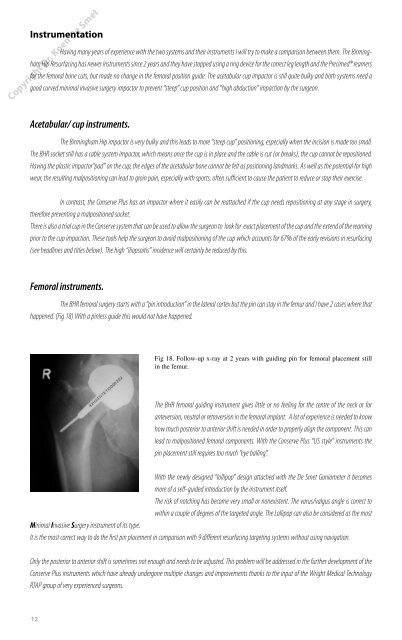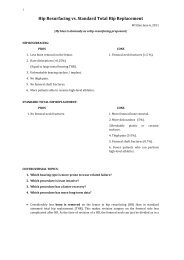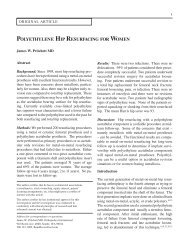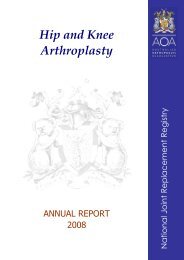Birmingham H ip Resurfacing v ersus C onserv e Plus M etal-on-M ...
Birmingham H ip Resurfacing v ersus C onserv e Plus M etal-on-M ...
Birmingham H ip Resurfacing v ersus C onserv e Plus M etal-on-M ...
Create successful ePaper yourself
Turn your PDF publications into a flip-book with our unique Google optimized e-Paper software.
Instrumentati<strong>on</strong><br />
Having many years of experience with the two systems and their instruments I will try to make a comparis<strong>on</strong> between them. The <str<strong>on</strong>g>Birmingham</str<strong>on</strong>g><br />
H<str<strong>on</strong>g>ip</str<strong>on</strong>g> <str<strong>on</strong>g>Resurfacing</str<strong>on</strong>g> has newer instruments since 2 years and they have stopped using a ring device for the correct leg length and the Precimed® reamers<br />
for the femoral b<strong>on</strong>e cuts, but made no change in the femoral positi<strong>on</strong> guide. The acetabular cup impactor is still quite bulky and both systems need a<br />
good curved minimal invasive surgery impactor to prevent “steep” cup positi<strong>on</strong> and “high abducti<strong>on</strong>” impacti<strong>on</strong> by the surge<strong>on</strong>.<br />
Copyright Dr. Koen De Smet<br />
Acetabular/ cup instruments.<br />
The <str<strong>on</strong>g>Birmingham</str<strong>on</strong>g> H<str<strong>on</strong>g>ip</str<strong>on</strong>g> impactor is very bulky and this leads to more “steep cup” positi<strong>on</strong>ing, especially when the incisi<strong>on</strong> is made too small.<br />
The BHR socket still has a cable system impactor, which means <strong>on</strong>ce the cup is in place and the cable is cut (or breaks), the cup cannot be repositi<strong>on</strong>ed.<br />
Having the plastic impactor”pad” <strong>on</strong> the cup, the edges of the acetabular b<strong>on</strong>e cannot be felt as positi<strong>on</strong>ing landmarks. As well as the potential for high<br />
wear, the resulting malpositi<strong>on</strong>ing can lead to groin pain, especially with sports, often sufficient to cause the patient to reduce or stop their exercise.<br />
In c<strong>on</strong>trast, the C<str<strong>on</strong>g><strong>on</strong>serv</str<strong>on</strong>g>e <str<strong>on</strong>g>Plus</str<strong>on</strong>g> has an impactor where it easily can be reattached if the cup needs repositi<strong>on</strong>ing at any stage in surgery,<br />
therefore preventing a malpositi<strong>on</strong>ed socket.<br />
There is also a trial cup in the C<str<strong>on</strong>g><strong>on</strong>serv</str<strong>on</strong>g>e system that can be used to allow the surge<strong>on</strong> to look for exact placement of the cup and the extend of the reaming<br />
prior to the cup impacti<strong>on</strong>. These tools help the surge<strong>on</strong> to avoid malpositi<strong>on</strong>ing of the cup which accounts for 67% of the early revisi<strong>on</strong>s in resurfacing<br />
(see headlines and titles below). The high “iliopsoitis” incidence will certainly be reduced by this.<br />
Femoral instruments.<br />
The BHR femoral surgery starts with a “pin introducti<strong>on</strong>” in the lateral cortex but the pin can stay in the femur and I have 2 cases where that<br />
happened. (Fig 18) With a pinless guide this would not have happened.<br />
12<br />
Fig 18. Follow-up x-ray at 2 years with guiding pin for femoral placement still<br />
in the femur.<br />
The BHR femoral guiding instrument gives little or no feeling for the centre of the neck or for<br />
anteversi<strong>on</strong>, neutral or retroversi<strong>on</strong> in the femoral implant. A lot of experience is needed to know<br />
how much posterior to anterior shift is needed in order to properly align the comp<strong>on</strong>ent. This can<br />
lead to malpositi<strong>on</strong>ed femoral comp<strong>on</strong>ents. With the C<str<strong>on</strong>g><strong>on</strong>serv</str<strong>on</strong>g>e <str<strong>on</strong>g>Plus</str<strong>on</strong>g> “US style” instruments the<br />
pin placement still requires too much “eye balling”.<br />
With the newly designed “loll<str<strong>on</strong>g>ip</str<strong>on</strong>g>op” design attached with the De Smet G<strong>on</strong>iometer it becomes<br />
more of a self-guided introducti<strong>on</strong> by the instrument itself.<br />
The risk of notching has become very small or n<strong>on</strong>existent. The varus/valgus angle is correct to<br />
within a couple of degrees of the targeted angle. The Loll<str<strong>on</strong>g>ip</str<strong>on</strong>g>op can also be c<strong>on</strong>sidered as the most<br />
Minimal Invasive Surgery instrument of its type.<br />
It is the most correct way to do the first pin placement in comparis<strong>on</strong> with 9 different resurfacing targeting systems without using navigati<strong>on</strong>.<br />
Only the posterior to anterior shift is sometimes not enough and needs to be adjusted. This problem will be addressed in the further development of the<br />
C<str<strong>on</strong>g><strong>on</strong>serv</str<strong>on</strong>g>e <str<strong>on</strong>g>Plus</str<strong>on</strong>g> instruments which have already underg<strong>on</strong>e mult<str<strong>on</strong>g>ip</str<strong>on</strong>g>le changes and improvements thanks to the input of the Wright Medical Technology<br />
RTAP group of very experienced surge<strong>on</strong>s.






